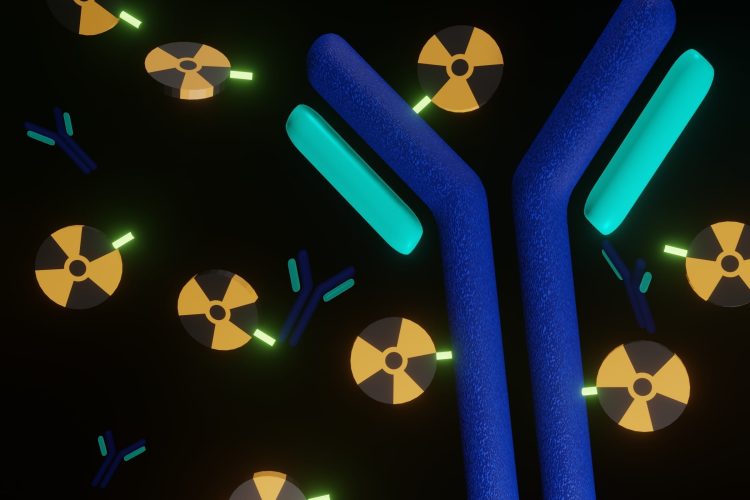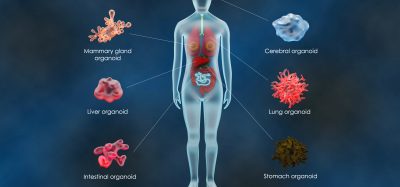From lab to clinic: the rise of Radio-DARPins in oncology
Posted: 30 July 2025 | Drug Target Review | No comments yet
As radioligand therapy continues to show promise, its application in solid tumours remains limited by long-standing biological challenges. In this interview, Julien Torgue, CSO at Orano Med, discusses a new collaborative platform – Radio-DARPins – and how it could help overcome key barriers to clinical progress.


Radioligand therapy (RLT) has emerged as a powerful modality in oncology, offering highly targeted delivery of radiation to cancer cells while sparing healthy tissues. Although RLT has already demonstrated success in certain haematological and prostate cancers, its application in solid tumours has historically faced a number of biological and technical challenges – from limited tissue penetration to off-target toxicity, particularly in organs like the kidneys.
Now, a collaborative programme between Orano Med and Molecular Partners is seeking to overcome these barriers through a new generation of therapeutics known as Radio-DARPins. Built on a platform that combines Orano Med’s expertise in targeted alpha therapy with Molecular Partners’ leadership in DARPin technology, the goal is to extend the reach of RLT in solid tumours with greater precision, efficiency and safety.
Julien Torgue, Chief Scientific Officer at Orano Med, has played a central role in shaping this joint initiative. In this interview, he shares insight into the science behind Radio-DARPins, the latest preclinical findings and why this platform could mark a turning point for radioligand therapy in solid tumours.
Two technologies, one goal: advancing precision oncology
With a background in biochemistry and biology, Julien oversees Orano Med’s internal and external research programmes. Among the most significant is the company’s strategic collaboration with Molecular Partners, aimed at developing up to ten therapeutic candidates based on a novel platform of Radio-DARPins. These agents combine designed ankyrin repeat proteins (DARPins) – small, engineered proteins designed for highly selective tumour targeting – with a therapeutic radioisotope. By coupling precise molecular recognition with the potent cell-killing effect of alpha radiation, Radio-DARPins are designed to deliver a highly localised radioactive payload to tumour cells while minimising damage to healthy tissues.
By bringing our respective expertise together, we were able to screen and rapidly identify suitable candidates for RLT.
The collaboration has proven mutually beneficial. “While Molecular Partners are the leaders in the development of DARPins, Orano Med is the leader in 212Pb-based radioligand therapy (RLT),” Julien explained. “By bringing our respective expertise together, we were able to screen and rapidly identify suitable candidates for RLT.”
The results of this partnership were shared at the American Association for Cancer Research (AACR) conference earlier this year, with two posters presented by Molecular Partners. These covered the two disclosed programmes within the collaboration – one targeting DLL3 in small-cell lung cancer (SCLC) and the other targeting mesothelin in solid tumours such as ovarian cancer.
The data, according to Julien, were both encouraging and affirming. “One provided an overview of the preclinical data for our upcoming IND filing for the DLL3 programme,” he said. “A second poster, on the mesothelin programme, focuses on the development of a Radio-DARPin against a membrane proximal epitope, justifying further development efforts.”
Why DARPins matter
So, what makes Radio-DARPins so exciting?
“DARPins are a very attractive vector for radioligand therapy for different reasons,” Julien said. These small, engineered proteins blend the key advantages of the two main vectorisation worlds – the selectivity and binding strength of antibodies with the rapid uptake and clearance of peptides. Importantly, they also allow for faster identification of initial hits and a broader range of possible targets. This versatility is crucial when aiming to create multiple therapeutic assets from a common platform.
The conserved structure of DARPins is another significant advantage, as it allows carrying over properties identified in one project to the next.
Another key benefit lies in their structural predictability. “The conserved structure of DARPins is another significant advantage, as it allows carrying over properties identified in one project to the next,” he said. This is particularly impactful when it comes to reducing development timelines – a major challenge in drug discovery.
One of the long-standing hurdles in radioligand therapy has been kidney retention, a toxicity issue that occurs when low molecular weight vectors are filtered through the kidneys but are not properly excreted. Julien acknowledged the difficulty: “Kidney retention is a tricky topic for low molecular weight vectors in radioligand therapy.”
“Kidney retention is a tricky topic for low molecular weight vectors in radioligand therapy.
Thanks to Molecular Partners’ deep experience, the team achieved a breakthrough. “They were able to optimise the surface charge of their DARPins and very significantly reduce their natural propensity to be retained in the kidneys,” he said. “Seeing a greater than tenfold reduction in renal retention was something we were hoping for and were very pleased when this was achieved.”
This degree of optimisation in vector design, balancing safety with therapeutic efficacy, is key to the strength and promise of the Radio-DARPin platform.
DLL3 and mesothelin: advancing Radio-DARPins toward the clinic
Among the first targets explored is DLL3, a protein expressed in over 80 percent of small-cell lung cancer cases but minimally present in healthy tissues. “Most importantly, DLL3 is homogeneously expressed, with low to no expression on healthy tissues,” Julien said.
The preclinical data has ticked all the boxes. “We have observed tumour-to-kidney ratios above two in biodistribution and a good safety profile. We also saw excellent tumour control and significantly increased survival in efficacy studies.” With investigational new drug (IND)-enabling studies now complete, Orano Med is preparing to submit a filing to the US Food and Drug Administration (FDA) and is aiming to initiate clinical trials later this year.
We have observed tumour-to-kidney ratios above two in biodistribution and a good safety profile. We also saw excellent tumour control and significantly increased survival in efficacy studies.
The second disclosed target, mesothelin, is particularly relevant in ovarian cancer. Here, the team had to overcome a more complex binding challenge due to the protein’s tendency to shed from tumour cells. Despite this, the platform’s value became quickly evident. “While it took many iterations to achieve the desired tumour-to-kidney profile on the DLL3 project, here, we already achieved a satisfactory tumour-to-kidney ratio,” Julien noted.
“That was extremely satisfying to see, as it demonstrated that the platform approach with DARPins is not only feasible but could also result in real-time savings.”
This ability to apply knowledge from one project to the next, without starting from scratch, highlights the scalability and efficiency of the Radio-DARPin platform – a rare trait in oncology drug development.
A pipeline with real potential
Beyond scientific innovation, what stands out in this story is the pace of development. Molecular Partners, armed with its DARPin engineering know-how, generated successive batches of candidates which Orano Med tested in its preclinical labs. “Molecular Partners has been a great partner,” Julien affirmed. “The promising results obtained on the collaboration made us realise that the initial agreement needed to be expanded… which is why we announced the expanded collaboration earlier this year.”
That extended partnership speaks volumes about the confidence both parties have in the platform’s potential.
The promising results obtained on the collaboration made us realise that the initial agreement needed to be expanded… which is why we announced the expanded collaboration earlier this year.
Looking ahead, the next step is clear: clinical validation. “We are currently preparing the US FDA IND filing and targeting an entry in the clinic later this year for the imaging and therapeutic cohorts on the DLL3 programme,” Julien said. “This will hopefully be the first of many Radio-DARPins we bring to the clinic.”
Orano Med also brings another powerful advantage to the table – its unmatched access to 212Pb, the alpha-emitting isotope that powers its radioligands. “We are the only one with access to what essentially represents an unlimited supply of the raw material,” Julien explained.
“We have been the longest player in the field, with a late-phase clinical trial, the only FDA Breakthrough Therapy Designation (BTD) for an alpha radioligand therapy (RLT) and the most diverse 212Pb-based pipeline.”
This combination of a novel targeting modality, a well-established isotope supply and proven expertise in radiopharmaceuticals places Orano Med and Molecular Partners in a highly advantageous position as they transition into clinical trials.
A platform built for impact
It is easy to be swept up in the technical detail of Radio-DARPins but what matters most is their potential to transform outcomes for patients. With small-cell lung cancer and ovarian cancer as initial indications, and additional targets expected through the expanded partnership, the platform has the potential to address some of the most challenging solid tumours.
As the field of radioligand therapy rapidly evolves, it is becoming increasingly clear that next-generation targeting systems like DARPins – and strategic partnerships like this one – will be the engine that drives innovation. With science, timing and teamwork aligning, Orano Med’s Radio-DARPins may well prove to be the game-changer the industry has been waiting for.


Julien Torgue has been the Chief Scientific Officer (CSO) of Orano Med since 2010. His career started as a Project Manager at Goodwin Biotechnology, where he oversaw the development, production and preparation of CMC (Chemistry, Manufacturing, and Controls) documentation for antibodies intended for clinical trials. In 2010, he joined Orano Med as CSO. In this role, he was tasked with filing an IND for the first in human use of lead-212, which was submitted to the FDA in December 2010, managing the clinical trials that followed and multiple other scientific partnerships with academic and industrial partners. Over the years, he has played a key role in the strategic development of the company and continues to oversee Orano Med research programs and external collaborations, while driving the ramp-up of Orano Med’s activities. He graduated from Florida Institute of Technology with a B.S. in Biochemistry, and a Ph.D. in Biology.
Related topics
Antibodies, Assays, Cancer research, Cell-based assays, Clinical Trials, Drug Delivery, Drug Development, Drug Discovery, Drug Discovery Processes, In Vivo, Molecular Biology, Molecular Targets, Oncology, Peptide Therapeutics, Personalised Medicine, Radiometric assays, Sequencing, Small molecule, Therapeutics
Related conditions
Ovarian cancer, Small cell lung cancer (SCLC)
Related organisations
Orano Med
Related people
Julien Torgue (Chief Scientific Officer at Orano Med)








